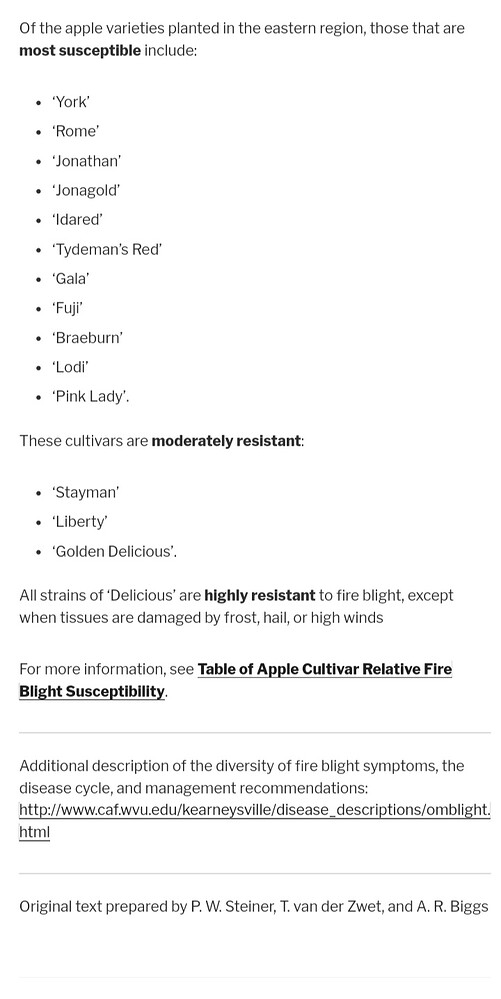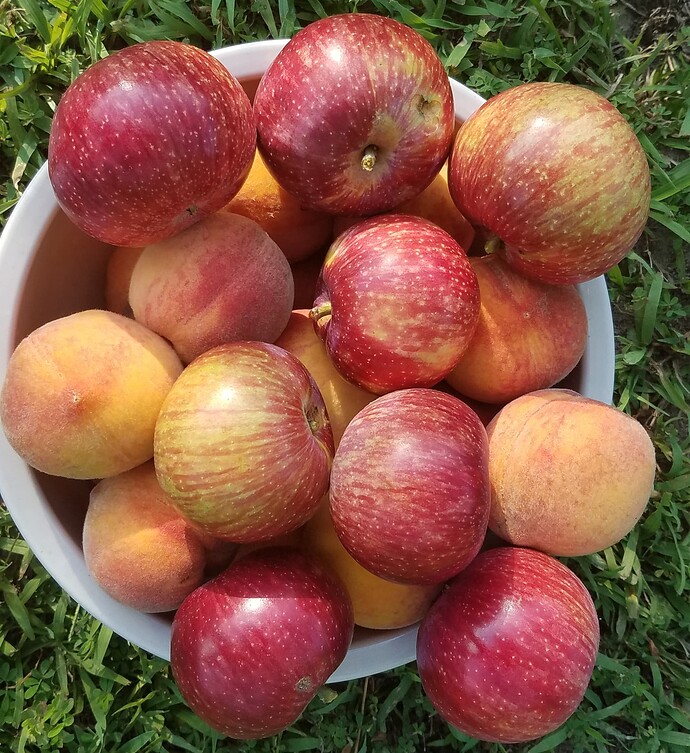Are you looking to grow the most disease resistant apples you can get? Im going to borrow from this article but give them credit they are due
https://apples.extension.org/table-of-apple-cultivar-fire-blight-susceptibility/
And this article
"
Freedom Apple](https://foodforestnursery.com/product/freedom-apple/) (Highly resistant): The Freedom Apple variety is known for its exceptional resistance to fire blight, making it a top choice for those seeking to minimize the risk of this bacterial disease. This variety produces large, red apples with crisp and juicy flesh, perfect for fresh eating and cooking.
Apple Trees – 39th Parallel Nursery & Orchard Lawrence, Kansas
Enterprise Apple](https://foodforestnursery.com/product/enterprise-apple/) (Highly resistant): Enterprise Apple trees are another excellent option for those looking to plant fire blight-resistant varieties. These trees are highly resistant to the disease and produce medium to large-sized, deep red apples with a tart and mildly sweet flavor, suitable for both eating fresh and processing.
Apple Trees – 39th Parallel Nursery & Orchard Lawrence, Kansas
Honeycrisp Apple (Moderately resistant): As a moderately resistant variety, Honeycrisp Apple trees exhibit some level of protection against fire blight. These trees produce large, juicy, and sweet apples with a unique honey-like flavor that has made them a favorite for fresh eating."
Arkansas black
"
Organic
Earl Holt, son of the early Arkansas settler, Jack Holt, owned the first commercial nursery in the state around 1850. His brother, De Kalb Holt, originated the Arkansas Black apple tree a few years later. Strikingly beautiful, the Arkansas Black apple, as the name suggests, is dark purple becoming nearly black apple at maturity. The Arkansas Black apple has very crisp flesh, coarse, greenish-white, sharp flavor, improving with age. Keeps all winter. The Arkansas Black apple trees is one of the best apples for hot interior locations. Also the Arkansas Black apple tree is suggested to do well in many California coastal zones which often have hot fall weather allowing the fruit to ripen. Resistant to cedar-apple rust and some resistance to scab and fireblight. Consider Grimes Golden, and/or Newtown Pippin for pollination. Please see below for further information on our organically grown Arkansas Black apple trees for sale. Tree out of nursery around 3 to 4 ft this season.
Considerations for Arkansas Black Apple
USDA Zones: 5, 6, 7, 8, 9,10"
Priscilla -50°F. Starking Delicious X PRI 610-2. Ripens in early-mid September. Red.**
Very productive annual bearer that tends to overbear if fruit not thinned. Field immune to scab; also resistant to fireblight and cedar apple rust. Medium-size fruit has good taste and crisp flesh with licorice undertones.
Melba
Early McIntosh
" Ripens earlier than other McIntosh! This vibrant red, easy-peel fruit has a sweet-tart taste and cream-white flesh. Complex flavor and spice make it a good choice for fresh-eating and especially sauces and cider. Keeps well (1 to 2 months in proper storage). Cold-hardy. Ripens in early August. Pollinator required: Choose another early or mid-blooming apple variety. See Recommended Pollinators below. A licensed variety of Cornell University."
Early McIntosh Apple Tree - Stark Bro’s
Northwestern Greening
"
type: Culinary, Cider, Pie
synonyms: Northwestern Greening
identification: Medium, sometimes very large. Usually round, but it can vary in shape and is often irregular. The skin is tough, pale green maturing to yellowish, sometimes faintly blushed on the sun exposed face and develops a waxy feel. Marked with small, raised lenticels. The stem is short to medium length and set in a cavity that can vary from wide to narrow and deep to shallow, sometimes russetted with rays spreading over the shoulder. The calyx moderately large and open, set in a shallow and wide basin.
characteristics: The flesh is yellowish, coarse-grained, somewhat firm, dense and crisp. Juicy, slightly sweet-tart, faint pear-drop flavour. Brix 11
uses: Primarily used for baking, makes great pies, a bit on the tart side. Often used for cider.
origins: Raised from a pippin—allegedly a cross of Golden Russet, American with Alexander —by Jasen Hatch of Iola, Wisconsin (U.S.A.), in 1849. The resulting seedling was then used as rootstock for another variety which ultimately failed. The seedling was ultimately overlooked until it started to produce fruit. When E.W. Daniels of Auroraville, Wisconsin sampled the apples in the 1870s, he undertook to promote the variety and introduced them in 1872.
cultivation: Vigorous, upright spreading tree with a drooping growth habit. Branches tend to be somewhat brittle. Starts to bear fruit beyond five years and bears every other year.
cold storage: Keeps three months in storage.
vulnerabilities: Resistant to fire blight and cedar apple rust.
harvest: Ready for harvest in the last half of the fourth period. Fruit hangs well at maturity.
pollination group: C
pollination peak: 8
ploidism: Diploid. Self sterile.
cold storage weeks: 12
brix: 11.7
harvest period: 4
hardiness: 2
sg: 1.0471"
Empire
" Description
The flavor of McIntosh with the sweetness of Delicious. This productive tree is disease-resistant to fire blight and cedar apple rust. You can plant it farther south than other McIntosh and expect better color. Originates from Geneva, New York circa 1945. Introduced in 1966. Cold-hardy. Ripens in September. Pollinator required: Choose another apple variety. See recommended pollinators below. A licensed variety of Cornell University."
Viking
"
type: Culinary, Cider, Dessert, Juice, Pie, Sauce
synonyms: There is also a similar cultivar named Gurney Viking that originated in South Dakota (U.S.A.) in the early 1900s.
summary: A big and bold maroon apple that’s both crisp and juicy with a sweet-tart flavour that stands up to fresh eating as well as baking.
identification: Large tending to very large size. Round. Skin is smooth and glossy. The base colour is green, washed dark red over more than half of the surface. A slight bloom forms on the surface when ripe. The stem short and moderately stout, set in a deep and narrow cavity. The calyx is small and closed, set in a narrow and deep basin.
characteristics: The flesh is cream-coloured, fine-grained. Sweet-tart and aromatic. Rose and lychee flavours. Browns heavily and quickly on exposure to air.
uses: A good fresh eating apple for those who favour tart, juicy and unique flavour profiles. Excellent when cooked or baked. Also used for cider.
origins: Selected as the first in the PRI cooperative scab-resistant apple breeding programme between Purdue University (West Lafayette, Indiana, U.S.A.), Rutgers University (New Brunswick, New Jersey, U.S.A.) and the University of Illinois (Illinois, U.S.A.), PRI 1033-5 was a complex cross of Jonathan , Red Delicious , Malus floribunda and William’s Early Red, Early McIntosh , Starr and Rome Beauty . However, it was found to be susceptible to scab and, as such, it contravened the aims of the PRI programme and was to have been discarded. Some of the apples did fall into the hands of growers and were deemed to be excellent eating apples, tasty enough to overlook the vulnerability. In 1969 it was unofficially released at the Wisconsin Agricultural Experiment Station under the name Viking.
cultivation: Vigorous. Semi-spur. Precocious.
progeny: Viking is the pollen parent of Co-op 43 , better known as Juliet.
cold storage: Keeps at best one month.
vulnerabilities: Though one of many apples developed in the PRI programme to breed disease resistant varieties, this one is susceptible to scab.
harvest: Ready for harvest in the middle of the third period. Bruises easily. Stays on branch beyond maturity but tend to fall in hot weather.
pollination peak: 1
ploidism: Diploid. Self sterile.
cold storage weeks: 4
harvest period: 4
hardiness: 3"
-50°F. Unknown parentage. Ripens in early-mid September. Red.
Large fruit with juicy white flesh and a slightly tart flavor. Does not drop prematurely. Tree is a vigorous grower.




